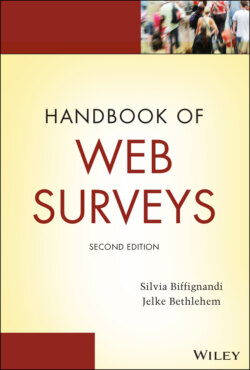Читать книгу Handbook of Web Surveys - Jelke Bethlehem - Страница 10
Chapter One The Road to Web Surveys 1.1 Introduction
ОглавлениеWeb surveys are a next step in the evolution process of survey data collection. Collecting data for compiling statistical overviews is already very old, almost as old as mankind. All through history, rulers of countries used statistics to take informed decisions. However, new developments in society always have had their impact on the way the data were collected for these statistics.
For a long period, until the year 1895, statistical data collection was based on complete enumeration of populations. The censuses were mostly conducted to establish the size of the population, to determine tax obligations of the people, and to measure the military strength of the country. The idea of sampling had not emerged yet.
The year 1895 marks a fundamental change. Populations had grown bigger and bigger. It was the period of industrialization. Centralized governments required more and more information. The time was ripe for sample surveys. The first ideas emerged around 1895. There was a lot of discussion between 1895 and 1934 about how to select samples: by means of probability sampling or some other sample selection technique.
By 1934, it was clear that only surveys based on probability sampling could provide reliable and accurate estimates. Such methods of data collection were accepted as a scientific. In the period from 1940s to the 1970s, most sample surveys were probability based. Questionnaires were on paper forms. They were completed in face‐to‐face, telephone, or mail.
Somewhere in the 1970s another significant development started. The fast development of microcomputers made it possible to introduce computer‐assisted interviewing (CAI). This made survey data collection faster, cheaper, and easier and increased data quality. It was time in which acronyms like CATI (computer‐assisted telephone interviewing) and CAPI (computer‐assisted personal interviewing) emerged.
The next major development was the creation of the Internet around 1982. When more and more persons and companies got access to the Internet, it became possible to use this network for survey data collection. The first Internet surveys were e‐mail surveys. In 1989 the World Wide Web was developed. This software allowed for friendly graphical user interfaces for Internet users. The first browsers emerged and the use of Internet exploded. In the middle of 1990s, the World Wide Web became widely available, and e‐mail surveys were increasingly replaced by web surveys.
Web surveys are attractive because they have a number of advantages. They allow for simple, fast, and cheap access to large groups of potential respondents. Not surprisingly, the number of conducted web surveys has increased rapidly over time. There are, however, also potential methodological problems. There are ample examples of web surveys not based on probability sampling. Therefore, generalization of survey results to the population is questionable. The interviewed may access the Internet using various types of devices. Thus, web surveys can be completed and received not only on personal computer (PC) or laptop; it is highly probable the survey to be received in the mobile phone. The so‐called mobile web surveys are fully part of web surveys. This implies some methodological problems to be considered, and further research on the impact of mobile is called for.
This chapter describes the historical developments that have led to the emergence of web surveys. As an illustration, Section 1.3 shows how these developments were implemented at Statistics Netherlands and led to new software for survey data collection.
